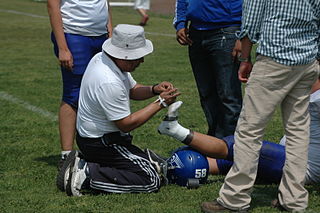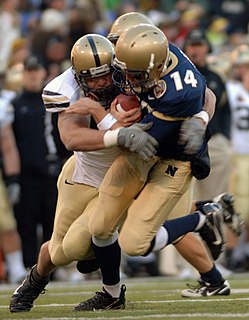 W
WSports injuries are injuries that occur during sport, athletic activities, or exercising. In the United States, there are approximately 30 million teenagers and children combined who participate in some form of organized sport. Of those, about three million athletes age 14 years and under experience a sports injury annually. According to a study performed at Stanford University, 21 percent of the injuries observed in elite college athletes caused the athlete to miss at least one day of sport, and approximately 77 percent of these injuries involved the lower leg, ankle, or foot. In addition to those sport injuries, the leading cause of death related to sports injuries is traumatic head or neck occurrences. When an athlete complains of pain or an injury, the key to a diagnosis is to obtain a detailed history and examination. An example of a format used to guide an examination and treatment plan is a S.O.A.P note or, subjective, objective, assessment, plan. Another important aspect of sport injury is prevention, which helps to reduce potential sport injuries. It is important to establish sport-specific dynamic warm-ups, stretching, and exercises that can help prevent injuries common to each individual sport. Creating an injury prevention program also includes education on hydration, nutrition, monitoring team members “at risk”, monitoring at-risk behaviors, and improving technique. Season analysis reviews, preseason screenings, and pre-participation examinations are also essential in recognizing pre-existing conditions or previous injuries that could cause further illness or injury. One technique that can be used in the process of preseason screening is the functional movement screen. The functional movement screen can assess movement patterns in athletes in order to find players who are at risk of certain injuries. In addition, prevention for adolescent athletes should be considered and may need to be applied differently than adult athletes. Lastly, following various research about sport injury, it is shown that levels of anxiety, stress, and depression are elevated when an athlete experiences an injury depending on the type and severity of the injury.
 W
WAchilles tendon rupture is when the Achilles tendon, at the back of the ankle, breaks. Symptoms include the sudden onset of sharp pain in the heel. A snapping sound may be heard as the tendon breaks and walking becomes difficult.
 W
WA biceps tendon rupture is a complete or partial rupture of a tendon of the biceps brachii muscle. It can affect the distal tendon, or either/both of the proximal tendons, attached to the long and short head of the muscle, respectively.
 W
WA boxer's fracture is the break of the 5th metacarpal bones of the hand near the knuckle. Occasionally it is used to refer to fractures of the 4th metacarpal as well. Symptoms include pain and a depressed knuckle.
 W
WCauliflower ear is an irreversible condition that occurs when the external portion of the ear is hit and develops a blood clot or other collection of fluid under the perichondrium. This separates the cartilage from the overlying perichondrium that supplies its nutrients, causing it to die and resulting in the formation of fibrous tissue in the overlying skin. As a result, the outer ear becomes permanently swollen and deformed, resembling a cauliflower.
 W
WChronic traumatic encephalopathy (CTE) is a neurodegenerative disease linked to repeated blows to the head. The encephalopathy symptoms can include behavioral problems, mood problems, and problems with thinking. The disease often gets worse over time and can result in dementia. It is unclear if the risk of suicide is altered.
 W
WHead injuries in sports of any level are the most dangerous and sickening kind of injuries that can occur in sport, and are becoming more common in Australian sport. Concussions are the most common side effect of a head injury and are defined as "temporary unconsciousness or confusion and other symptoms caused by a blow to the head." A concussion also falls under the category of Traumatic Brain Injury (TBI). Especially in contact sports like Australian rules football and Rugby issues with concussions are prevalent, and methods to deal with, prevent and treat concussions are continuously being updated and researched to deal with the issue. Concussions pose a serious threat to the patients’ mental and physical health, as well as their playing career, and can result in lasting brain damage especially if left untreated. The signs that a player may have a concussion are: loss of consciousness or non-responsiveness, balance problems, a dazed, blank or vacant look and/or confusion and unawareness of their surroundings. Of course the signs are relevant only after the player experiences a blow to the head.
 W
WConcussions in England's professional rugby union are the most common injury received. Concussion can occur where an individual experiences an impact to the head. Commonly occurring in high contact sporting activities; American football, boxing, mma and the rugby codes. It can also occur in recreational activities like horse riding, jumping, cycling, and skiing. The reason being that it doesn't have to be something to strike you in the proximity of your brain, but can also be caused by rapid change of movement, giving the skull not enough time to move with your body, causing your brain to press against your skull. With rugby being such a contact and fast moving sport, it is no wonder why there is concussion and other head injuries occurring. With the development of equipment and training methods, these will help benefit the players on the field know what could happen and how they can help with preventing it.
 W
WGolfer's elbow, or medial epicondylitis, is tendinosis of the medial epicondyle on the inside of the elbow. It is in some ways similar to tennis elbow, which affects the outside at the lateral epicondyle.
 W
WHealth issues in American football comprise a large number of health risks associated with participating in the sport. Injuries are relatively common in American football, due to its nature as a full-contact game. Injuries occur during both practice and games. Several factors can affect the frequency of injuries: epidemiological studies have shown older players can be at a greater risk, while equipment and experienced coaches can reduce the risk of injury. Common injuries include strains, sprains, fractures, dislocations, and concussions. Concussions have become a concern, as they increase the risk of mental illnesses like dementia and chronic traumatic encephalopathy (CTE). In individual leagues like the National Football League (NFL) and National Collegiate Athletic Association (NCAA), a public injury report is published containing all injured players on a team, their injury and the game-day status of each player.
 W
WIn organized athletics, few situations give rise to greater anxiety than the 'downed athlete'. Obvious causes include head and neck injury, or both, with no immediate means of excluding neck injury in the athlete who may be unable to give a history. Compounding the problem is the potential for the athlete's airway being compromised. Such a situation requires effective triage with the possibility of the athlete's injury being worsened or its effects being made permanent, if the initial steps taken are not appropriate. Paradoxically, the equipment designed to prevent or mitigate injury, such as helmets, face masks, neck rolls and shoulder pads, contributes to the complexity of the steps needed to be taken. Finally, environmental challenges, such as the difficulty of first responders moving on an ice arena, or maneuvering an ambulance through inadequate access routes, will add to the problem if not previously addressed by inspection of facilities and, in the best circumstances, rehearsal.
 W
WHelmet-to-helmet collisions are occurrences in gridiron football when two players' helmets make head-to-head contact with a high degree of force. Intentionally causing a helmet-to-helmet collision is a penalty in most football leagues, including many high school leagues.
 W
WA knee dislocation is a knee injury in which there is a complete disruption of the joint between the tibia and the femur. Symptoms include knee pain and instability of the knee. Complications may include injury to an artery around the knee, most commonly the artery behind the knee, or compartment syndrome.
 W
WLittle League elbow is a condition that is caused by repetitive throwing motions, especially in children who play sports that involve an overhand throw. "Little Leaguer's elbow" was coined by Brogdon and Crow in an eponymous 1960 article in the American Journal of Radiology.
 W
WMusculoskeletal injury refers to damage of muscular or skeletal systems, which is usually due to a strenuous activity. In one study, roughly 25% of approximately 6300 adults received a musculoskeletal injury of some sort within 12 months—of which 83% were activity-related. Musculoskeletal injury spans into a large variety of medical specialties including orthopedic surgery, sports medicine, emergency medicine and rheumatology.
 W
WSwimming injuries have many different causes, which can occur immediate or can occur as the result of a long-term swimming career. Some ways that swimmers can increase the risk of an injury are by overuse of a specific part of the body, lacking crucial flexibility and strength, etc. These injuries, like swimmer’s shoulder and breaststroker’s knee, cause pain to the swimmer in certain regions that permit necessary movement for the required precise technique. Although these injuries can halt a professional swimmer’s career, many can be treated and some can even be prevented. There are different procedures and exercises that can either prevent an injury or help with recovering from an injury. Many of the exercises are specific to the injury and vary in helpfulness according to the person and the technique used for the exercise.
 W
WTennis elbow, also known as lateral epicondylitis, is a condition in which the outer part of the elbow becomes painful and tender. The pain may also extend into the back of the forearm and grip strength may be weak. Onset of symptoms is generally gradual. Golfer's elbow is a similar condition that affects the inside of the elbow.
 W
WVolleyball is a game played between two opposing sides, with six players on each team, where the players use mainly their hands to hit the ball over a net and try to make the ball land on the opposing team's side of the court. Volleyball is played by over 800 million people world wide, making it one of the most popular sports in the world. Volleyball has some risks involved with it because there are some injuries which occur to players that are quite common; these include ankle injuries, shoulder injuries, foot injuries and knee injuries.